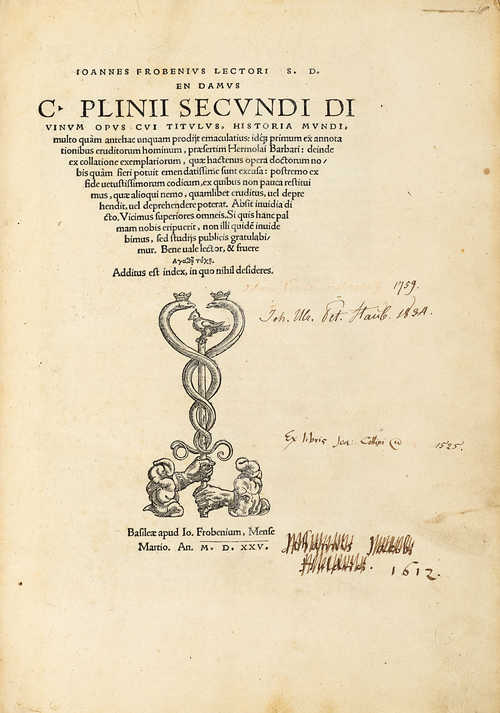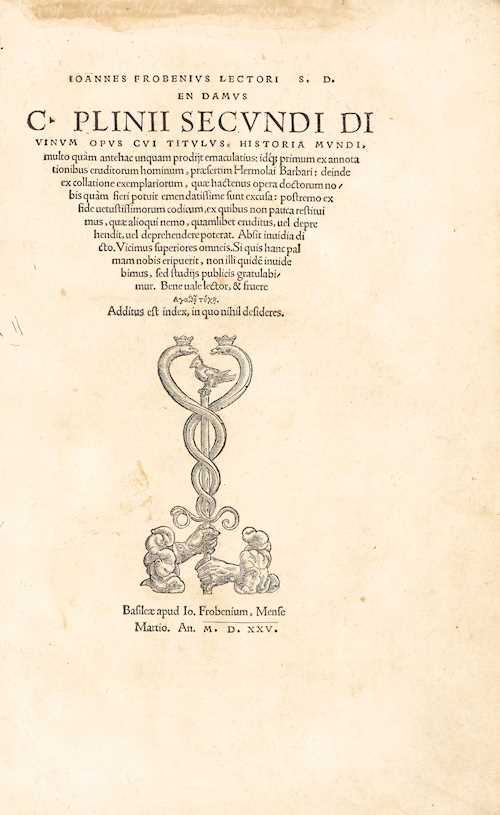PLINIUS SECUNDUS, Gaius (23-79). Historia naturalis . Edited by Joannes Andreae de Buxiis (1417-75), Bishop of Aleria, and Theodorus Gaza. Rome: Conradus Sweynheym and Arnoldus Pannartz, [not after 30 August] 1470. Royal 2° (393 x 274 mm). Collation: [1 10 2 12 3-6 10 7-11 8 12-17 10 18-20 8 21-27 10 28-29 8 30-37 10 38-39 8 40 10 ] (1/1 blank, 1/2r editor's dedicatory letter to Pope Paul II, 1/2v letters from Pliny the Younger to Marcus and Tacitus (comprising an account of his uncle's life and the circumstances of his death), and citations from Suetonius, Tertullian, and Eusebius of Caesarea, 1/4v dedication by Pliny the Elder to Domitian, 1/5v tables and indices, including lists of sources (=Book 1), 3/1r Book 2, 9/1r Book 7, 12/1r Book 9, 14/1r Book 11, 16/1r Book 13, 21/1r Book 18, 31/1r Book 28, 40/8r colophon, 40/9-10 blank). 376 leaves (of 378, without the last two blanks). 46 lines. Type 2:115R. Spaces for 7-line initials and for headings, unrubricated. (Occasional very minor marginal foxing or soiling, light dampstaining to a few leaves, a few insignificant marginal tears.) 18th-century calf, spine gilt in compartments, morocco lettering-piece, edges speckled red and green (joints cracked and with minor repairs at head and tail). Provenance : 16th- and 17th-century marginalia (occasionally cropped); 18th- or 19th-century ink shelfmark W.I.6 inscribed on front flyleaf; Earl of Hopetoun, armorial bookplate (sale, Sotheby's, 25 February 1889, lot 937, £17.10 to Quaritch); C. S. Ascherson, bookplate. SECOND EDITION, printed in 300 copies, a few months after the first edition printed by Johannes de Spira in Venice in 1469. Giovanni Andrea Bussi states in his prefatory letter that Teodoro Gaza assisted him in his editorial work. The preface implies that the editors were unaware of the existence of the De Spira edition, which was printed from a different and more corrupt manuscript. (In 1473 Sweynheym and Pannartz printed another edition of Pliny, the last book from their press, which is based on yet a different recension of the text.) The present edition was the first produced by their press in the year 1470, as indicated by the list of the printers' works published in their 1471-72 Nicolaus de Lyra, and as attested by the fact that this is the latest of their editions to have the headings left to the rubricator rather than being printed. The unrubricated state of this copy and absence of early ownership marks may indicate that it was one of a number of copies of Sweynheym and Pannartz's earlier Roman output to have remained in stock "sufficiently long to be finally sold rather as curiosities than for reading" (Scholderer, BMC IV, p. viii). In his great encyclopaedia, the first comprehensive examination of the natural sciences and the arts, Pliny set forth by his own count 20,000 facts compiled from 2,000 different works, all of which he scrupulously cited in his remarkably thorough indices. The 36 books of this vast compilation, the only extant work of more than 100 said to have been composed by Pliny, cover cosmology, geography, medicine, zoology, botany, history, philosophy, anthropology, mineralogy, and the arts and literature. When Pliny died at age 56 while observing the eruption of Mt. Vesuvius, the work was still unfinished. The importance of the Historia naturalis for the study of ancient art has been somewhat overshadowed by its renown as the first encyclopaedia of natural history. In fact, the Historia remains a principal source of information on the development of sculpture and painting and the techniques of metalworking and silversmithing in antiquity, topics covered in the last four books. Together with Vitruvius's De architectura , Pliny's work is one of few extant testimonies to the flowering of art criticism and art historical study in the Roman period. This edition is rarer than both the preceding and succeeding editions, although the colophon of De Spira's edition states a print-run of 100 copies
PLINIUS SECUNDUS, Gaius (23-79). Historia naturalis . Edited by Joannes Andreae de Buxiis (1417-75), Bishop of Aleria, and Theodorus Gaza. Rome: Conradus Sweynheym and Arnoldus Pannartz, [not after 30 August] 1470. Royal 2° (393 x 274 mm). Collation: [1 10 2 12 3-6 10 7-11 8 12-17 10 18-20 8 21-27 10 28-29 8 30-37 10 38-39 8 40 10 ] (1/1 blank, 1/2r editor's dedicatory letter to Pope Paul II, 1/2v letters from Pliny the Younger to Marcus and Tacitus (comprising an account of his uncle's life and the circumstances of his death), and citations from Suetonius, Tertullian, and Eusebius of Caesarea, 1/4v dedication by Pliny the Elder to Domitian, 1/5v tables and indices, including lists of sources (=Book 1), 3/1r Book 2, 9/1r Book 7, 12/1r Book 9, 14/1r Book 11, 16/1r Book 13, 21/1r Book 18, 31/1r Book 28, 40/8r colophon, 40/9-10 blank). 376 leaves (of 378, without the last two blanks). 46 lines. Type 2:115R. Spaces for 7-line initials and for headings, unrubricated. (Occasional very minor marginal foxing or soiling, light dampstaining to a few leaves, a few insignificant marginal tears.) 18th-century calf, spine gilt in compartments, morocco lettering-piece, edges speckled red and green (joints cracked and with minor repairs at head and tail). Provenance : 16th- and 17th-century marginalia (occasionally cropped); 18th- or 19th-century ink shelfmark W.I.6 inscribed on front flyleaf; Earl of Hopetoun, armorial bookplate (sale, Sotheby's, 25 February 1889, lot 937, £17.10 to Quaritch); C. S. Ascherson, bookplate. SECOND EDITION, printed in 300 copies, a few months after the first edition printed by Johannes de Spira in Venice in 1469. Giovanni Andrea Bussi states in his prefatory letter that Teodoro Gaza assisted him in his editorial work. The preface implies that the editors were unaware of the existence of the De Spira edition, which was printed from a different and more corrupt manuscript. (In 1473 Sweynheym and Pannartz printed another edition of Pliny, the last book from their press, which is based on yet a different recension of the text.) The present edition was the first produced by their press in the year 1470, as indicated by the list of the printers' works published in their 1471-72 Nicolaus de Lyra, and as attested by the fact that this is the latest of their editions to have the headings left to the rubricator rather than being printed. The unrubricated state of this copy and absence of early ownership marks may indicate that it was one of a number of copies of Sweynheym and Pannartz's earlier Roman output to have remained in stock "sufficiently long to be finally sold rather as curiosities than for reading" (Scholderer, BMC IV, p. viii). In his great encyclopaedia, the first comprehensive examination of the natural sciences and the arts, Pliny set forth by his own count 20,000 facts compiled from 2,000 different works, all of which he scrupulously cited in his remarkably thorough indices. The 36 books of this vast compilation, the only extant work of more than 100 said to have been composed by Pliny, cover cosmology, geography, medicine, zoology, botany, history, philosophy, anthropology, mineralogy, and the arts and literature. When Pliny died at age 56 while observing the eruption of Mt. Vesuvius, the work was still unfinished. The importance of the Historia naturalis for the study of ancient art has been somewhat overshadowed by its renown as the first encyclopaedia of natural history. In fact, the Historia remains a principal source of information on the development of sculpture and painting and the techniques of metalworking and silversmithing in antiquity, topics covered in the last four books. Together with Vitruvius's De architectura , Pliny's work is one of few extant testimonies to the flowering of art criticism and art historical study in the Roman period. This edition is rarer than both the preceding and succeeding editions, although the colophon of De Spira's edition states a print-run of 100 copies













Testen Sie LotSearch und seine Premium-Features 7 Tage - ohne Kosten!
Lassen Sie sich automatisch über neue Objekte in kommenden Auktionen benachrichtigen.
Suchauftrag anlegen